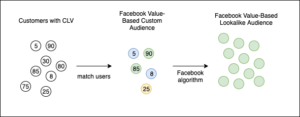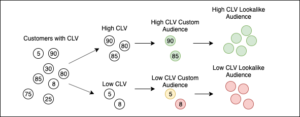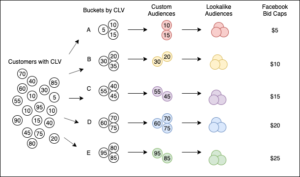Are you finding it increasingly more expensive to acquire customers on Facebook? Are the customers you acquire spending less and threatening your profitability?
We’ve seen these problems across a number of our clients, so we leveraged our Facebook insider knowledge to come up with 3 new strategies that give you superpowers over the competition. Using these techniques, our clients have seen cost reductions of up to 25%. Simultaneously, they increase the quality and quantity of customers they acquire.
“This is the best targeted marketing approach on Facebook” – Former Head of Facebook Business Marketing Operations
We’re excited to share these three strategies and how you can implement them for yourself.
Facebook Ad Targeting Basics
When you run ads on Facebook, you place bids in a real-time auction for positions in the news feed of Facebook users. The way that everyone starts out is to bid on users based on interest, age, gender, and location. However, because everyone does this, this strategy usually underperforms in the auction. As a result, you to either lose the bids or display ads to users who would never buy your product.
Facebook offers an existing solution called Lookalike Audiences to improve this situation. Lookalike Audiences are created by first uploading a list of customer identifiers (facebook click ids, email addresses, etc) to Facebook. Facebook then creates a Custom Audience by matching current Facebook users to those identifiers. You then create a Lookalike Audience from the Custom Audience, relying on Facebook to apply its own algorithm for finding users that are similar to those in the original list.
When you use a Lookalike Audience to run ads on Facebook, you take advantage of the hundreds of details that Facebook has about each user. This includes the content that those users post to Facebook, what they view, like, or share, how they describe their interests, and much more. Using all of these details, Facebook can create a much clearer picture of the type of person who buys your products than could be done with mere targeting by age, gender, and location.
Shortcomings of Lookalike Audiences
However, Lookalike Audiences are not perfect. That’s because not all of your customers actually are alike. There are probably several types of people who buy your product, which will confuse Facebook’s lookalike algorithm since it is looking for a single type of user to target.
Also, not all of your customers are of equal value to you. Your loyal customers spend repeatedly and consistently and are very valuable to you. On the other hand, other customers only respond to steep discounts, with little loyalty, and are not very valuable to you. Basic Lookalike Audiences don’t understand these differences in customer value.
To improve this situation, we need to first think more deeply about customer value.
Customer Lifetime Value Can Help
In order to improve the returns from the customers you acquire, you first need to know the full value of your customers beyond their first purchase. The sum of the past and future value for each individual customer is called Customer Lifetime Value (CLV). If you measure value based on the total sales of each customer, you over-value your older customers and under-value your more recent customers.
When your data team is labeling the CLV for each of your customers, make sure they provide a single and consistent measuring stick to value your customers. They may be using either gross sales or net margin, depending on what makes the most business sense. The important thing is that they apply that decision in a consistent manner.
With CLV labeled for each one of your customers, you unlock the following three strategies for better marketing using Facebook:
Strategy 1: Value-Based Lookalike Audiences
This type of audience leverages Facebook’s own algorithm to show your ads only to users with high CLV. It is the simplest way to leverage CLV to improve your customer acquisition, and we’ve found it to be effective with a number of different brands.
To create a Value-Based Lookalike Audience,
- Generate CLV for each customer and match it to an identifier such as email address
- Upload that data to Facebook to create a Value-Based Custom Audience. Facebook will then match its users to the customers which you uploaded
- Create a Lookalike Audience based on that custom audience. This will become your new Value-Based Lookalike Audience
- Facebook applies their algorithm to look for what defines a high CLV customer (green in the picture below) and populates the lookalike audience with users of the same type.
- When running new acquisition campaigns, use this new lookalike audience, and exclude current customers from the custom audience

How Value-Based Custom Audiences Work
In this process, Facebook looks at the users in the Value-Based Custom Audience, and tries to figure out what high value customers have in common. This could be a combination of hundreds of different factors including the types of content those users like, post, or share, their interests, and the interests of their friends. Your Facebook campaign will then only bid on and be shown to users who resemble your high-value customers.
This reduces cost by reducing the number of times you need to display your ad (impressions) in order to generate a successful sale. It also increases your revenue by acquiring customers with higher and more frequent spending habits—that is, by acquiring higher-CLV customers.
However, for some marketers, this type of audience may still not have the desired performance. That’s because it relies on Facebook’s algorithm. Facebook may be targeting users too broadly, which results in reduced conversion rates for you, but more spend/revenue for Facebook. In such cases, we recommend the second type of audience.
Strategy 2: High/Low Value Audiences
To more tightly target high CLV customers and avoid low CLV customers, it can make sense to generate two audiences. This approach is slightly more complex, but gives you more control over how tightly to target your ads. It also reduces your dependency on Facebook’s own business logic which comes built-in with their algorithm.
To implement this strategy:
- Start with labeling the CLV for each of your customers
- Divide your customers into two lists: high CLV and low CLV. It is best to use the top and bottom 20% (approximately) of your customers in order to emphasize the differences between the two.
- Upload each list to Facebook and create a normal (not Value-Based) Custom Audience
- Facebook will then match its users to the lists you uploaded
- Create a Facebook lookalike audience for each of the lists
- When running new acquisition campaigns, use the high-CLV lookalike audience. Exclude both the low-CLV lookalike audience and your current customers

Iterating On Your High and Low CLV Audiences
You can adjust the percentages of your users included in each of the lists and/or the percentage of Facebook users included in the lookalike audiences. Be sure to leverage any additional knowledge you may already have as to what makes your strongest customers. For example, to reduce the chances of acquiring low-CLV customers, pull a targeted list composed of the lowest value 10% of your users. Next, create a broad/large lookalike audience for your excluded low-CLV audience. If you are using content targeted at a particular segment of your customers, then you can filter the high-CLV list to only include customers in that segment.
This strategy gives you more control by relying on your own definition of the type of customer you wish to acquire. It is ideal whenever your cost of acquisition is high compared to your average customer lifetime value and your main priority is to improve upon that ratio.
If instead you are trying to maximize the number of customers acquired, we have developed a third strategy.
Strategy 3: Value-Based Bidding
When advertising on Facebook, there is a trade-off between the maximum amount you are willing to spend to get your ads displayed (bid cap), and the number of times it will get shown (impressions). If you spend more, you will win more bids, but your costs will increase.
The idea behind Value-Based Bidding (VBB) is that even low CLV customers are worth acquiring, as long as you don’t spend too much to acquire them. VBB is a strategy that uses multiple audiences at multiple bid caps. In this way, you optimize for bringing in more customers while also ensuring an appropriate margin on the customers you acquire.
To implement VBB, start by defining your spend limit—that is to say, define your target CLV to CAC ratio. If your market is highly competitive, you may need to spend nearly as much to acquire your customers as you derive from their full lifetime value in order to win the bids. So, you may need a ratio like 1.5::1. If there is less competition for your customers, or if you prioritize profitability over quantity, you can maximize your returns by targeting a CLV to CAC ratio as high as 4:1.
Implementing Value-Based Bidding on Facebook
Once you have a target CLV to CAC ratio, the steps to implementing this strategy are:
- Start with the labeled CLV for each of your customers
- Divide your customers into 5 buckets by CLV, labeled A through E, each containing 20% of your customers. Bucket A contains the 20% of your customers with the lowest CLV, bucket B contains the next 20% of customers who have a higher CLV than those in bucket A, and so on
- For each bucket, find the average CLV of those customers. Apply your target CLV to CAC ratio to come up with the maximum amount you would spend to acquire similar customers
- Create a normal (not Value-Based) Custom Audience in Facebook for each bucket
- For each custom audience, create a lookalike audience in Facebook
- Create multiple tiered acquisition campaigns as follows:
-
- For bucket A, start a campaign with a bid cap set at the target CAC. Use the lookalike audience for bucket A and exclude your current customers
- Next, for bucket B, start a campaign with a bid cap set at the target CAC. Use the lookalike audience for bucket B and exclude the lookalike audience from bucket A. Also exclude your current customers
- For bucket C, do the same as the above. This time, exclude the lookalike audiences from both buckets A and B, and your current customers.
- Etc.

This strategy takes some attention to detail to set up. But, it will maximize the number of customers you acquire. At the same time, VBB ensures an appropriate level of profitability via your target CLV to CAC ratio. Note that the Facebook algorithm for lookalike audiences is not perfect. This means the CLV you start with for a given bucket may not exactly match the CLV you realize from the customers you acquire using that bucket. Also note that there will be overlap between the audiences, so it is important to setup the audience exclusions in step 6.
Now, Choose Your Strategy
These three strategies provide you with superpowers in the ever-competitive realm of Facebook marketing. You may have competitors trying to sell to the same consumers, but you can still win those display ad bids. Be smarter and more targeted in how you set up your audiences and you’ll be all set. The users you acquire will not only convert and make purchases, but will also have a high customer lifetime value.
Value-Based Lookalike Audiences are a simple way to get started with using the power of CLV.
High/Low Value Audiences give you more control over the customers you target.
Value-Based Bidding maximizes the number of customers you acquire while maintaining profitability.
If you don’t already have the CLV for each of your customers, don’t worry. We at Retina have taken the latest research in predicting CLV, and turned it into a complementary service called Retina Go! which predicts the CLV for a sample of your customers for free. Retina Go! will also automatically implement these strategies for you. Give it a try! Or, if you have questions about other ways you can empower your business with CLV, we’d be happy to chat.